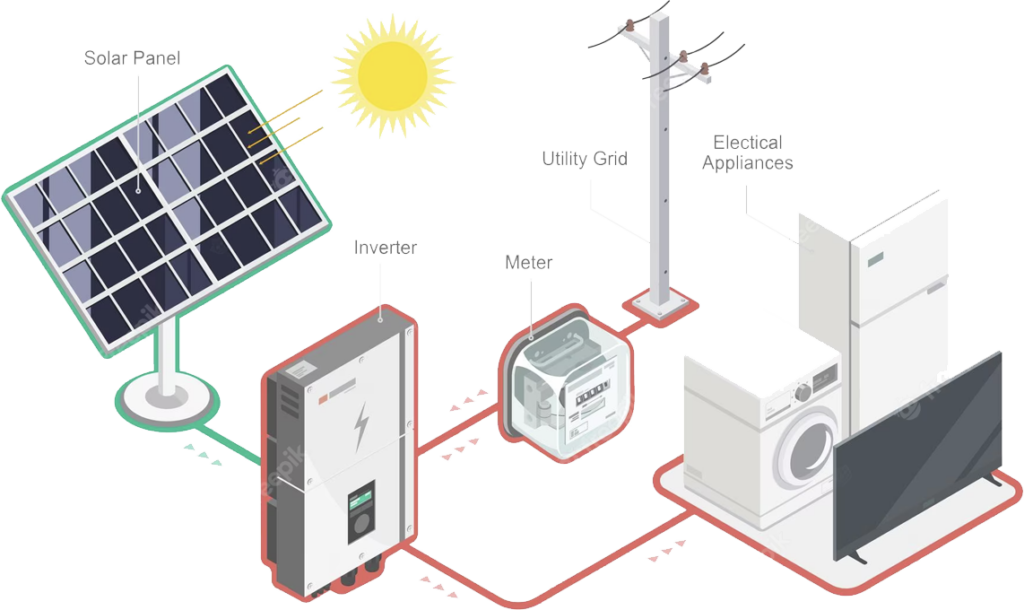Solar PV
Reduce your energy bills by 25-30% with Solar Photovoltaic - PV
- Solar PV is a nonmechanical device that converts sunlight directly into electricity.
- The solar panels will be fixed above the existing roof tiles on rails or on a ground mounted system.
- The solar panels convert light to DC electricity and the inverter converts this DC electricity into AC electricity for use in your home.
- The solar system is connected to your main electricity panel or fuseboard.
- You may have chosen to add other components such as an immersion diverter or a battery.
- The immersion diverter re-directs any unused electricity to heat the water in your immersion tank.
- By adding a battery you will store any electricity not being used for a later time, usually evening or night time. A battery will increase the percentage of the solar power you use in your home.
- Most solar panel installations take no more than a day.
- The work will be carried out on your roof, in your attic and at your fuse board.
- There will be little disruption to your daily routine.
Installing a solar PV system into your home can save between €200-300 per year on your domestic electric bill.
Solar panels that produce electricity are known as photovoltaic (PV). These panels work by capturing the suns energy using photovoltaic cells. It is these cells that convert sunlight into electricity for your home. Remember that PV panels don’t need direct sunlight to work – they still produce electricity on cloudy days which is ideal for Ireland.
Solar Panels have a long shelf life and are guaranteed for 20 years.
SEAI will pay up to €900 per kWp for systems up to 2kWp. This means the total grant you would receive for a 6/7 solar panel system would be €1800.
How Solar PV works
Solar PV panels in Ireland convert sunlight into electricity that can be used to power homes and businesses. They are typically installed on rooftops or in open spaces. When sunlight hits the solar panels, it creates an electric current through photovoltaic cells made of silicon. The electricity generated is converted from DC to AC by an inverter and used to power appliances.
Excess electricity can be fed back into the grid, reducing reliance on non-renewable sources of electricity.

What does the installation involve?
Any room with a wall being insulated will be assessed for ventilation. If the ventilation is inadequate, a new vent will have to be installed.
Different types of vents may be installed depending on the type of room and what is in the room:
- In rooms used for living and sleeping, fresh air can be provided naturally without the need to open a window.
- If there is a fireplace present (or a boiler), a permanently open vent will be required to reduce the risk of carbon monoxide poisoning.
- In kitchens, utility rooms and bathrooms (‘wet rooms’), a mechanical extract fan is necessary to remove any warm, moist air from the property.
If existing vents are not working effectively, changing the covers (internal and external) may correct the problem.
When a vent needs to be installed, it may be necessary to drill a hole large enough to accommodate the pipe for the vent. The pipe is placed through the wall and the internal and external covers fitted. Alternatively ventilation may be incorporated into the windows.
If an extract fan is required, your contractor will assess the location for it. They will need to create a hole in the wall and insert the pipe.
A fan will then be mounted on the wall or ceiling. this will need electricity to operate. An electrician will install any necessary cabling. Where possible cabling will be brought through existing containment, if this is not possible surface mounted containment will be installed.
Wall ventilation is usually carried out before or during the wall insulation measures. If extract fans are required, the vent will be installed by one team and an electrician will then need to wire up the fan. These visits may not necessarily be on the same day.







